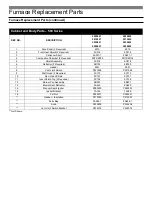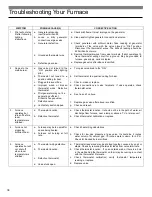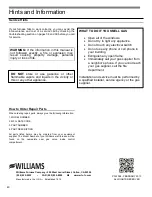
Troubleshooting Your Furnace
Troubleshooting Your Furnace (continued)
SYMPTOM
POSSIBLE CAUSE(S)
CORRECTIVE ACTION
6. Pilot outage.
a. Pilot flame may be low or
blowing (high).
b. Drafts or drafty areas.
a. Adjust pilot flame. Pilot orifice may be plugged (check for spider
webs or other material).
b. Check for doorway and high movement areas.
7. Noisy blower
.
a. Housing rattling.
b. Blower dirty.
c. Blower wheel bent.
a. Tighten blower screws.
b. Clean blower wheel.
c. Straighten or replace.
8. Blower does not
run.
a. Fan switch not set.
a. Select fan speed.
9. Main burner will
not stay on.
a. Blockage in vent pipe.
b. Vent too short.
c. Restriction in vent system
caused by offsets.
d. Incorrect vent pipe.
e. Loose connections on the
vent safety wiring harness.
a. Check vent pipe for blockage, such as bird nests, twigs, leaves, etc.
Check that the vent cap is properly installed, and not placed too far
down on the vent pipe. Cap must be the same manufacturer as the
vent.
b. The vent should terminate a minimum of 12 feet above the floor
plate. The top of the vent must be at least 2 feet above any
obstacle within a 10 foot radius, including the roof.
c. All type “B” vents shall extend in a vertical direction with offsets not
exceeding 45 degrees. Any angle greater than 45 degrees from
vertical is considered horizontal. Any offsets used should be a
minimum of 2-feet above the draft hood or as far away as possible
to allow venting to begin before any restriction is encountered. The
use of too many offsets may also prevent proper venting.
d. Use listed B/W type vent pipe. DO NOT use transite or any other
type of ceramic pipe for venting. DO NOT use single wall vent pipe.
When venting into a masonry chimney, the chimney must be
properly lined and sized for this gas furnace. The use of type “B” or
flexible chimney liner is recommended.
e. Check the connection on both the switch and the gas valve. Tighten
if necessary.
10. Abnormal
operation.
a. Delayed ignition. Pilot flame
may be too low.
b. Expansion noise, ticking.
c. Combustible gas spillage.
d. Excessive flame roll-out.
e. Burner is over-fired.
f. Yellow burner flame.
g. Yellow pilot flame.
h. Expansion noise
a. Adjust pilot flame. Refer to “How to Care for Your Furnace” section
in this manual.
b. Check installation. Casing may be distorted by being fastened to an
uneven opening or jammed under the header. A restricted vent may
create expansion noise. Refer to “Vent Installation” section in this
manual.
c. Check vent system for a blocked flue, excessive down draft (wind)
or negative pressure in room caused by a ventilating fan or a fire in
a fireplace.
d. Furnace is possibly overrated, check for high gas pressure at gas
valve. (See 4B).
e. Check the manifold gas pressure. Check the rate, this appliance is
manufactured for elevations up to 4,500 feet. It must be derated for
operation above 4,500 feet.
f. Check burner for obstructions. Install new burner and pilot orifices.
g. Remove pilot orifice, check and clean.
h. DO NOT elevate the furnace off the floor unless supported by the
free standing accessory. Never shear the legs. If replacing the
furnace, bring the vent pipe to the header. DO NOT raise the
furnace to the vent pipe. Legs must be flat on the floor plate, never
one in front of the other.


































